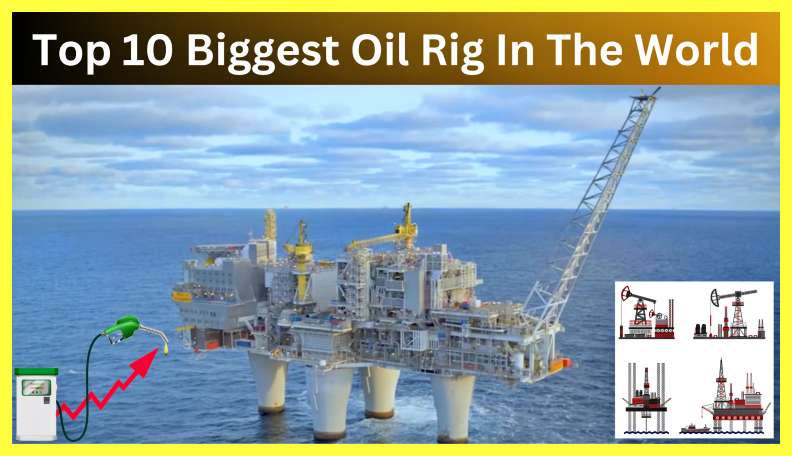Top 10 Biggest Oil Rig In The World
Table of Contents
Today we will give you the list of the Top 10 Biggest Oil Rig In The World with Images and related Information, Huge oil rigs are designed to withstand extreme conditions, which are used for drilling deep wells and can extract hundreds of thousands of barrels of oil every day.
An oil rig, also known as an offshore platform or drilling rig, is a large structure used for the exploration and extraction of oil and gas reserves located beneath the seabed. These structures are primarily situated in offshore areas such as oceans, seas, or large lakes, where significant oil and gas deposits are found.
Oil rigs are designed to withstand the demanding conditions of the marine environment and provide a stable platform for drilling operations. They are equipped with a wide array of facilities and equipment necessary for drilling, extracting, and processing oil and gas.
Here are some key components and features commonly found on an oil rig:
- Drilling equipment: This includes a drilling rig, drill string, drill bits, and various tools required for drilling into the Earth’s crust to reach oil and gas reservoirs.
- Derrick: A tall, tower-like structure that supports the drilling equipment and provides a stable platform for drilling operations.
- Wellhead: A structure that connects the wellbore with the drilling equipment. It consists of valves, fittings, and other equipment essential for controlling the flow of oil or gas.
- Accommodation facilities: Oil rigs provide living quarters for workers who reside and work on the platform. These quarters typically include bedrooms, kitchens, dining areas, recreational spaces, and medical facilities.
- Helipad: Many oil rigs are equipped with a helipad to facilitate the transportation of personnel and supplies via helicopters.
- Storage facilities: Oil rigs have storage tanks and facilities to temporarily hold the extracted oil and gas before they are transported to shore.
- Processing facilities: Depending on the rig’s capabilities, it may have facilities for processing oil and gas on-site, including the separation of impurities and initial refining processes.
- Safety systems: Oil rigs are equipped with a range of safety systems, such as fire suppression systems, lifeboats, emergency evacuation procedures, and safety equipment to ensure worker safety and prevent accidents.
- Support vessels: Additional ships or boats are employed to transport personnel, supplies, and equipment to and from the oil rig.
The operation of an oil rig involves drilling wells into the seabed, extracting oil and gas reserves, and transferring the resources to storage or processing facilities. The extracted oil and gas are typically transported to shore through pipelines, tankers, or other means of transportation for further refining and distribution.
It’s important to note that the specific design and operation of an oil rig can vary depending on factors such as the location, water depth, type of hydrocarbon reserves, and the operating company.
List of Top 10 Biggest Oil Rig In The World
These are the Biggest Oil Rigs in the World.
10. MITTELPLATE Oil Rig
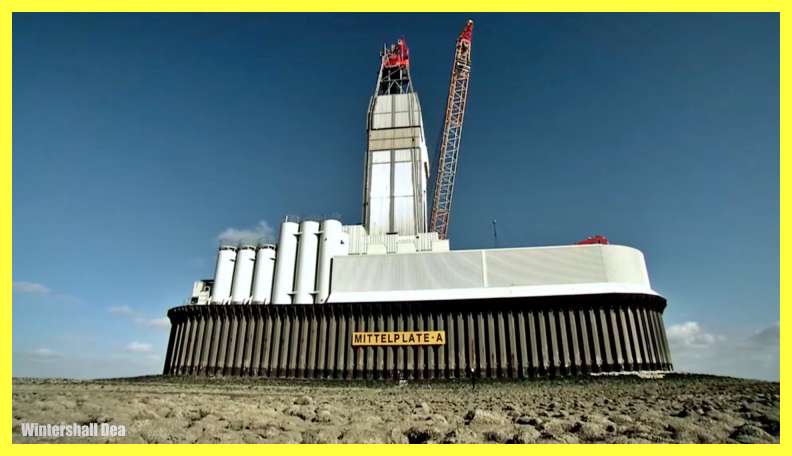
Located in Germany’s Wadden Sea Mudflats, the Mittelplate oil rig is the largest in the country. Built on an artificial island, it began operation in 1987 with a production capacity of 18,000 barrels per day. The rig extracts oil from over 25 wells and pumps it ashore through 7.5 km long pipelines. With a focus on renewable energy, Mittelplate has been safely producing oil for more than 35 years.
9. P-55 Oil Rig
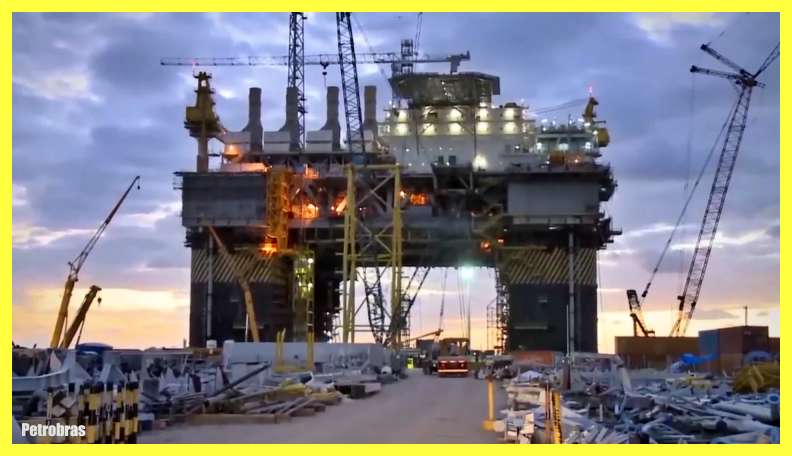
The P-55 oil rig is the largest semi-submersible platform ever built in Brazil. Situated 125 kilometers off the coast of Rio de Janeiro, it is anchored by 16 mooring lines at a depth of 1,800 meters. The platform connects to 11 extraction wells and 6 injection wells, and it has a daily capacity to process 180,000 barrels of oil, compress 6 million cubic meters of natural gas, and inject 290,000 barrels of water. Standing 130 meters tall and weighing 52,000 tons, it accommodates 120 people.
8. THUNDER HORSE Oil Rig
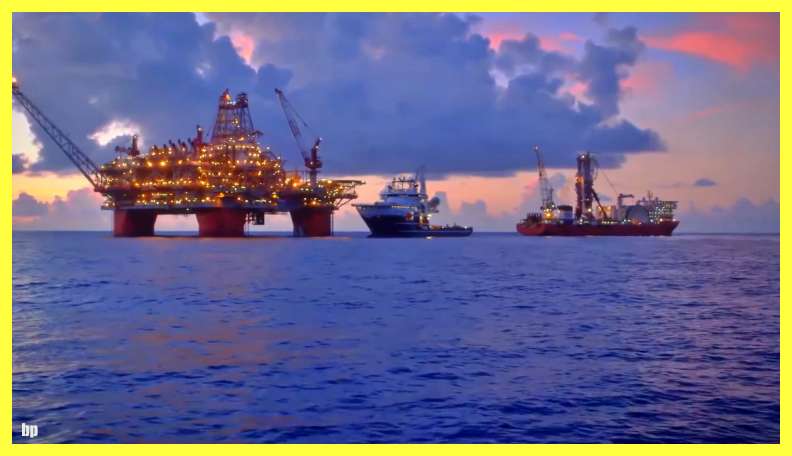
Located in the Gulf of Mexico, the Thunder Horse oil rig operates under extreme conditions. It began production in 2008, extracting oil and gas from a reservoir 5 kilometers beneath the mud and rock. With a height of 132 meters and a weight of 60,000 tons, it can withstand pressures exceeding 1,200 bar and temperatures of 135 degrees Celsius. The rig has a daily production capacity of 250,000 barrels of oil, 5.6 million cubic meters of gas, and it injects 300,000 barrels of water.
7. OLYMPUS “MARS B” Oil Rig
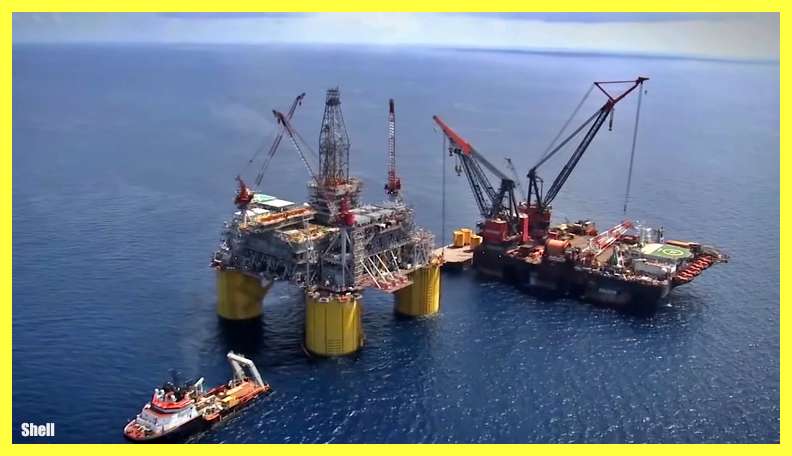
Situated in the Gulf of Mexico, the Olympus “MARS B” oil rig is a tension-leg platform designed to withstand extreme weather conditions. Moored to the seabed at a depth of 914 meters, it became operational in 2014 with a production capacity of 100,000 barrels of oil per day. Standing 121 meters tall and weighing 120,000 tons, it accommodates 192 people. The platform is connected to 24 drilling wells and is expected to operate beyond 2050.
6. PETRONIUS Oil Rig
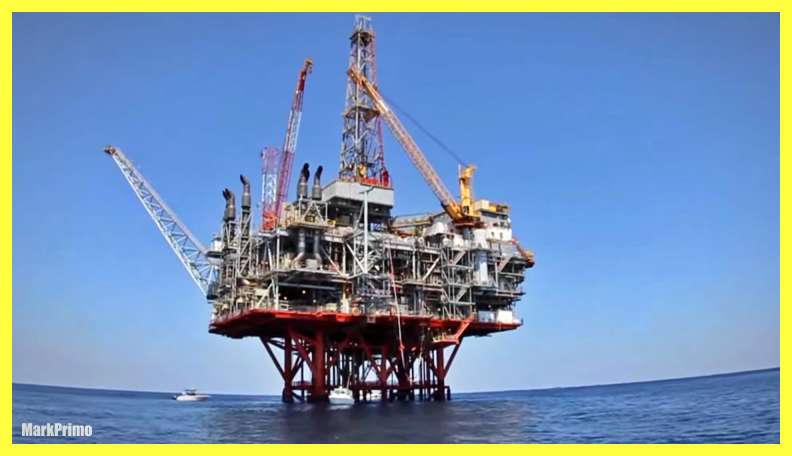
The Petronius oil rig, located in the Gulf of Mexico, is the tallest oil platform globally. Built in 2000, it stands 640 meters tall, of which 75 meters are above water. Designed to withstand extreme conditions like large waves, strong currents, and hurricanes, it weighs 50,000 tons. The rig has a daily production capacity of 60,000 barrels of oil and 2.8 million cubic meters of gas. The Petronius oil field, discovered in 1995, contains recoverable reserves of about 100 million barrels of oil.
5. PERDIDO Oil Rig
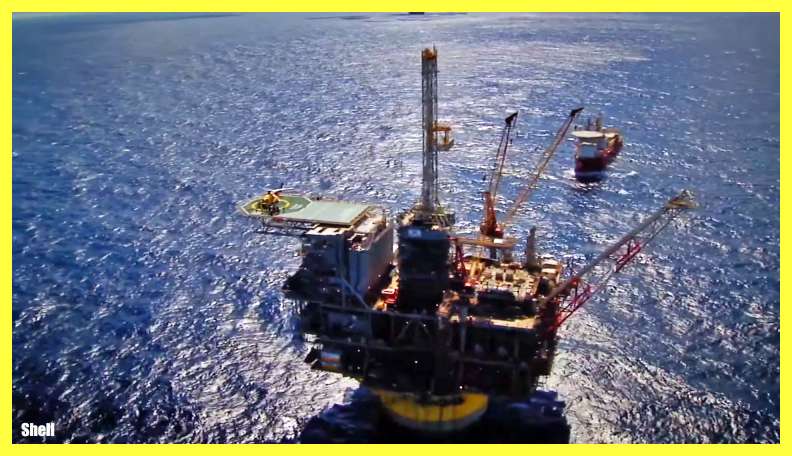
Situated in the Gulf of Mexico, the Perdido oil rig is the deepest floating platform globally, located at a depth of 2,450 meters. It began operation in 2010, extracting oil from 35 subsea wells connected by 44 kilometers of pipelines. Weighing 55,000 tons, its structure was designed to withstand extreme storms. The rig comprises three decks housing processing units, a drilling platform, and accommodations for 172 people. It has a daily production capacity of 100,000 barrels of oil and 5.6 million cubic meters of gas.
4. HIBERNIA Oil Rig
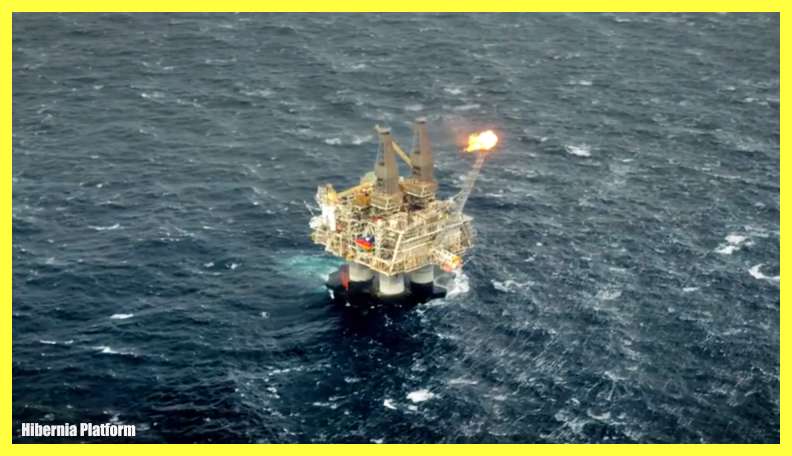
Located in Canada, the Hibernia oil rig is the heaviest offshore platform ever built. It is situated 315 kilometers from the coast of St. John’s, Newfoundland. The structure weighs 600,000 tons and can store 1.3 million barrels of oil. With a topside facility weighing 37,000 tons, it has a production capacity of up to 220,000 barrels of oil per day. The rig started oil production in 1997 and is expected to operate until after 2040.
3. HEBRON Oil Rig
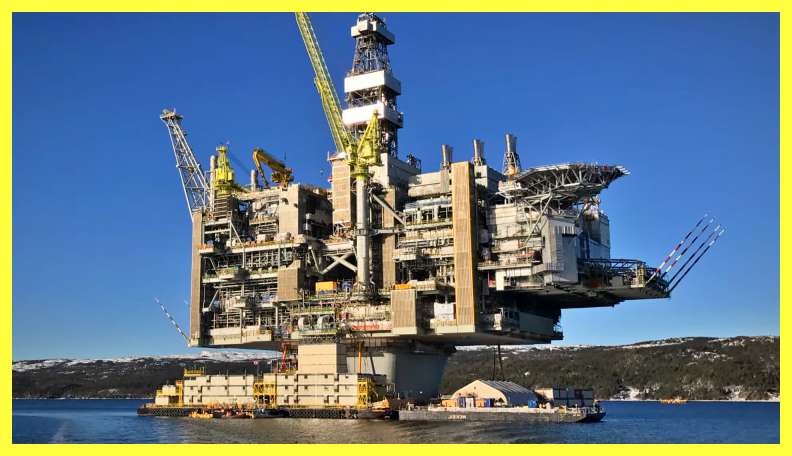
The Hebron oil rig, located in Canada, is designed to withstand sea ice, harsh weather, and oceanographic conditions. Its reinforced concrete structure rises 143 meters above sea level, with a weight of 750,000 tons and a storage capacity of 1.2 million barrels of oil. The rig can accommodate 220 people and has various facilities for multiple activities. It began operation in 2017, with a daily production capacity of 150,000 barrels of oil.
2. Troll A Oil Rig
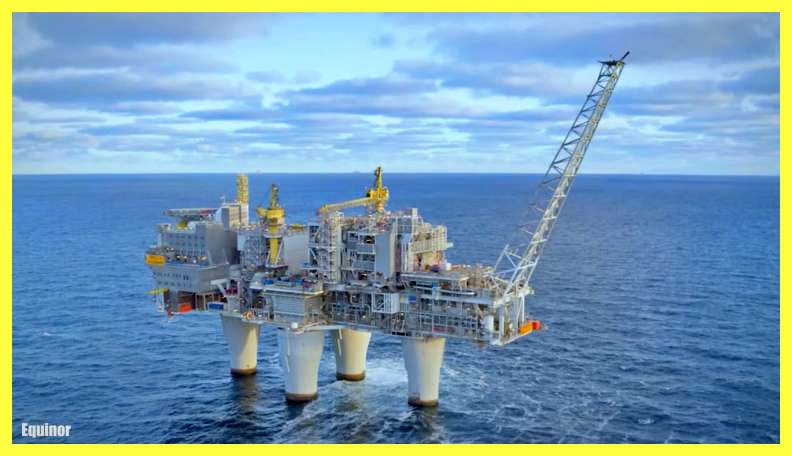
Situated in Norway, the Troll A oil rig is the tallest structure ever moved and one of the largest engineering projects in history. One of three platforms in the Troll field, it has extracted up to 400,000 barrels of oil per day. Standing at 472 meters tall and weighing 683,000 tons, its concrete-reinforced steel structure features four hollow legs containing elevators. The rig came online in 1996 and was built for a projected operational life of 70 years.
1. Berkut Oil Rig
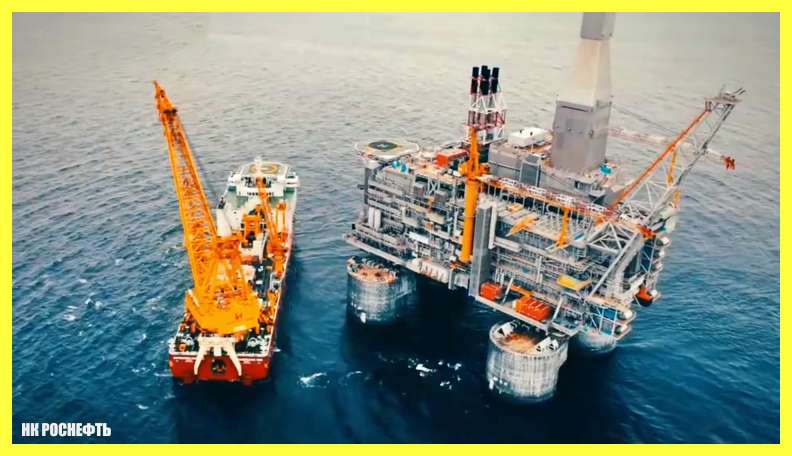
Located in the Sea of Okhotsk, 25 kilometers east of Sakhalin Island, Russia, the Berkut oil rig came into operation in 2014. Its structure is built with concrete and steel, with a weight exceeding 200,000 tons. Designed to withstand extreme conditions such as 18-meter waves, 2-meter-thick ice fields, and temperatures as low as 45 degrees below zero, it stands 144 meters high, 105 meters long, and 60 meters wide. The rig is connected to 45 oil wells and has a production capacity of over 90,000 barrels per day.
Table of Top 10 Biggest Oil Rig In The World
Here’s a table summarizing the information about the biggest oil rigs in the world:
| Rank | Oil Rig | Location | Characteristics | Production Capacity |
|---|---|---|---|---|
| 10 | MITTELPLATE | Germany | Largest oil rig in Germany | 18,000 barrels per day |
| 9 | P-55 | Brazil | Largest semi-submersible platform in Brazil – Daily capacity: 180,000 barrels of oil, 6 million cubic meters of gas, 290,000 barrels of water | – |
| 8 | THUNDER HORSE | Gulf of Mexico | Operates in extreme conditions with high pressures and temperatures | 250,000 barrels of oil, 5.6 million cubic meters of gas |
| 7 | OLYMPUS “MARS B” | Gulf of Mexico | Tension-leg platform designed for extreme weather conditions – Connected to 24 drilling wells | 100,000 barrels of oil per day |
| 6 | PETRONIUS | Gulf of Mexico | Tallest oil platform in the world – Can withstand extreme conditions like waves, currents, and hurricanes | 60,000 barrels of oil, 2.8 million cubic meters of gas |
| 5 | PERDIDO | Gulf of Mexico | Deepest floating oil platform in the world – Connected to 35 subsea wells | 100,000 barrels of oil per day, 5.6 million cubic meters of gas |
| 4 | HIBERNIA | Canada | Heaviest offshore oil platform ever built | Up to 220,000 barrels of oil per day |
| 3 | HEBRON | Canada | A reinforced concrete structure designed to withstand sea ice and harsh weather | 150,000 barrels of oil per day |
| 2 | Troll A | Norway | Tallest structure ever moved – One of the largest engineering projects in history | Up to 400,000 barrels of oil per day |
| 1 | Berkut | Russia | Located in the Sea of Okhotsk – Designed to withstand extreme conditions like waves, ice fields, and low temperatures | Over 90,000 barrels per day |
Please note that the production capacity for P-55 is not provided in the given information.
Also Read:
- Top 10 Best Snow Plow Trucks in the World
- Top 10 Best Spider Excavators in the World (Spider Machine)
- Top 10 Countries With Largest Uranium Reserves (2023-2024)
- Top 10 Best Military Armored Pickup Trucks in the World
- Top 10 Best Telescopic Crawler Cranes in the World
- Top 10 Best Pipe Laying Vessel in the World (Biggest)
